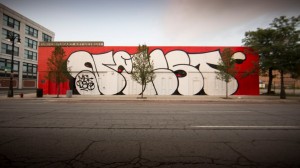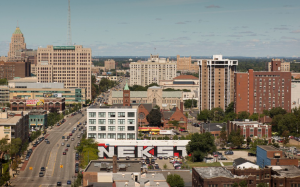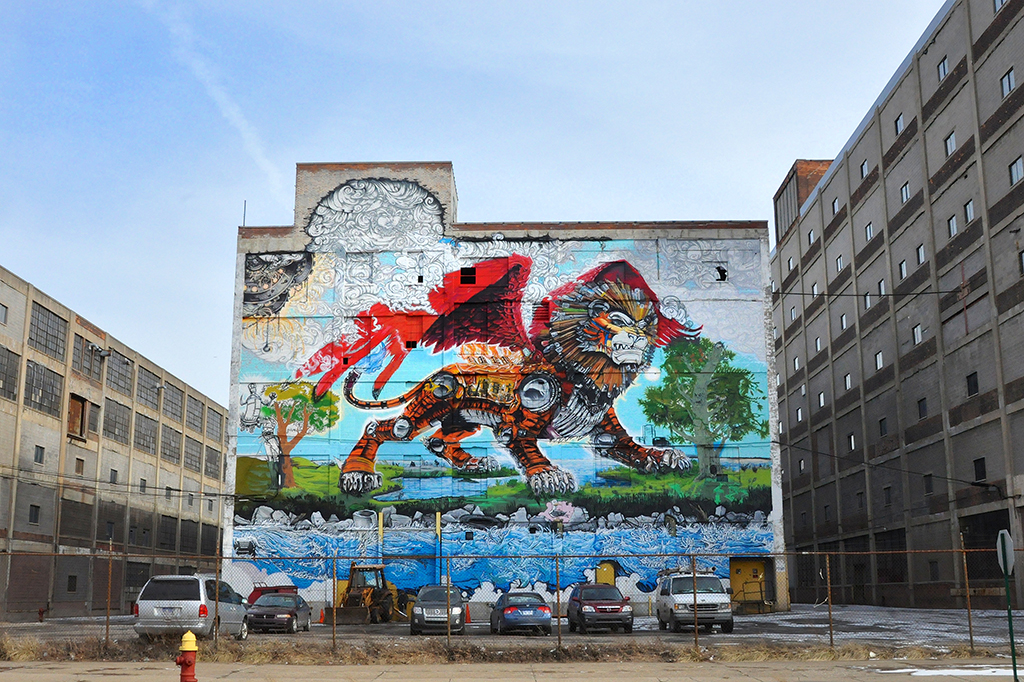(Photos courtesy of Chris Freitag, Pieces of Detroit)
Widely regarded as a colorful form of vandalism and an indication of a lesser affluent, crime-inflicted part of town, graffiti is rarely, if ever, viewed as a positive addition to any community.
But as community members in cities such as Detroit struggle to piece back together a city wrecked by economic tragedy, graffiti has become an important art form that has turned the dark, crumbling buildings in the largely abandoned Motor City into a visual display of hope.
Dale Carlson is the content director of ilovedetroitmichigan.com, a photo website dedicated to highlighting all of the graffiti art throughout the city. Carlson told MintPress that while most of the graffiti in Detroit is vandalism that can turn “nearly worthless, vacant, abandoned real estate into completely worthless, vacant, abandoned real estate,” he says “it is that very same vacant, abandoned real estate (and there is a ton of it in Detroit) that has provided the canvas that has facilitated a movement.”
The “movement” Carlson is referring to is known as the “Detroit Beautification Project,” which was started by world-renowned artist Revok in 2012, who said he wanted to help the city become an “epicenter of creativity” once again.
The project involved more than 20 premier graffiti artists coming to the city to create a series of murals in neighborhoods the artists felt needed them most.
Graffiti artist Pose, who was part of the project, said that the movement was “born out of a very American experience,” adding that it was a “basic human gesture” to paint the city for those who remained.
Coming together
Though the city was hit hard by the 2007 economic collapse, the truth is Detroit has been struggling financially for decades. During the last 30 years or so, it has seen about half of its population flee, leaving some 40 square miles — which is the equivalent to the size of San Francisco — vacant.
While some of the graffiti that decorates buildings throughout Detroit were commissioned as part of the Detroit Beautification Project and even by some local businesses, a lot of the art was also “illegally” painted — sometimes by artists who were brought in to paint those commissioned pieces.
“The amount of fully completed, legal, graffiti-style art pieces in Detroit right now is unheard of pretty much

anywhere else in the United States,” Carlson said. “It’s downright revolutionary the level of tolerance, acceptance and approval the art form has achieved here over the past few years. That ought to be recognized throughout the art world, and I believe it eventually will be, but credit is always slow in coming where Detroit is concerned.
“Detroit’s street art movement just might be a catalyst for an improved national public image in the coming years, but I can tell for certain that most people in metro Detroit do not give two craps what the rest of the world thinks of us and take great pride in being regarded as a dump by millions of people that have never even been here,” Carlson said. “What’s far more positive than an improved national public image, in my opinion, is being able to drive down the street and see art everywhere.”
Chris Freitag, of Pieces of Detroit, who is also writing a book on the city’s graffiti movement, agreed the surge in graffiti has been positive for the city.
“Even though the city is falling apart and we have a corrupt government, the people will find a way to put the work into everything they do. Find a way to make something special, beautiful and express themselves,” he said.
Speaking on behalf of the people of Detroit, Freitag explained that because the city is under such duress, the perception in Detroit is that graffiti has been a “positive influence in neighborhoods,” and not a form vandalism.
While Detroit has been in trouble for the past 30 years, Freitag says the situation intensified in the past five to 10 years, which is why many believe that turning vacant and crumbling buildings into outdoor murals is not a bad thing for the city.
Although it appears no work has been commissioned (yet) by local government officials, city officials have opted to not destroy illegally-painted works on some city buildings.
Carlson says part of what has attracted so many artists to the Detroit area is that the city is already filled with a ton of talented artists, and there is a lot of vacant, un-monitored, unsecured buildings.
“It’s a marriage of convenience, resulting from a unique confluence of social and economic forces that has snowballed into an innovative movement,” he said.
The art world appears to agree.
Graffiti’s art world debut
Though the debate rages on around the world whether the graffiti art movement in cities like Detroit is actually art, according to art historians, graffiti may be one of the oldest forms of art. And according to the U.S. Department of Justice Office of Community Oriented Policing Services, there are different types of graffiti, but all are displayed in public rather than in a gallery.
Although sometimes graffiti does find its way inside a gallery.
The Brooklyn Museum, for one, has had many exhibitions on graffiti and street art, and the Museum of Contemporary Art in Los Angeles recently had a large graffiti exhibit, which was one of the highest attended exhibits ever.
Sharon Matt Atkins, managing curator of Exhibitions at the Brooklyn Museum, told MintPress that the museum features graffiti paintings and says graffiti art doesn’t have to be on buildings.
“Some artists who are using graffiti and street art use sculptures or do prints,” she said. “There is no one single definition.”

The Museum of Contemporary Art Detroit has also embraced graffiti and even had a piece commissioned to be painted on the side of its building.
In an email to MintPress, Executive Director Elysia Borowy-Reeder said that “Graffiti has always been about contemporary issues,” adding that MOCAD “embraces all types of mediums and methods of presenting art that fuels a critical dialogue.”
Borowy-Reeder said that what attracts people to this type of art is the general accessibility of it all.
“It can be a voice for people that may not be heard in normal circumstances,” she said.
Carlson agreed and told MintPress that one thing that attracts him to the art is the “public-ness” of graffiti and street art. What Carlson says he means by that is that while museums are sometimes free, and the art therein might be owned by the public, “but art on exterior walls, to me, speaks to the concept of free, unfettered access so much louder than art on the interior.”
“As any art, with the right tools and critical dialogue it can be engaging,” Borowy-Reeder added. “What matters is how the art and the community work together, and at MOCAD we try to facilitate those types of
discussions and be a leader in the resurgence in Detroit’s vibrant art scene.”
Not everyone’s a fan…
Although a plethora of people appreciate the work the graffiti artists have put into beautifying the city, there is a handful who would describe the work of the graffiti artists as “disgusting” and have asked local lawmakers to clean-up the buildings — but not at the taxpayers expense.
Detroit resident Michelle Trzin, who describes herself as being old-school, says she doesn’t think graffiti artists should be allowed to paint on local buildings.
“You take a building bought in the 1920s and you put graffiti on it; no one’s going to buy it then,” Trzin said. “We’re still trying to preserve some of the older culture … [they’re] trying to make it this hip, artsy town, but it’s not,” she said.
Some law enforcement officers agree and say that even though a building is abandoned, a graffiti artist does not have the right to paint it.
Jonathan Rocha, an officer in the Los Angeles Police Department’s Newton Division’s Gang Enforcement Detail, said that while he recognizes many of the artists are talented, he says the artists have to recognize it’s still a crime.
“That’s the bottom line,” he said. “You can admire it, but at the end of the day, it’s somebody’s property that’s being defaced, and our ultimate goal is to stop that.”
Some law enforcement officials in Detroit have continued to crackdown on illegal graffiti, but Freitag says it happens much less. He said if they do stop a kid for painting an uncommissioned piece, the officers are more likely to just give them a scolding instead of having them spend a “considerable amount of time in jail.”
Carlson agreed that Detroit police have become more tolerant of spray-painters painting in public places so long as permission has been given. But he says officers “will still bust your ass hard for painting without [permission].”
Luckily for those painting illegally, Carlson says police patrols have been super thin in Detroit these days, which has allowed for “tons of great illegal pieces” to be painted throughout the city.
Breaking the stereotypes
Jail time for painting a picture on the side of a building may sound like a fair punishment for those who believe graffiti artists to be gang-members involved in criminal activity, but most of the artists in Detroit are nothing like the stereotypical graffiti artist.
Atkins told MintPress many of the artists actually have formal art training, and added that while some of their work is done on the street, they often have work that is shown in galleries and museums.
Freitag agreed that a lot of misconceptions abound about the artists themselves, explaining that like other things in life, graffiti attracts people from all walks of life. From those in their late teens to early 20s, to the kids from the suburbs to the hardcord Detroit-lifers, to artists from all over the world, Freitag says the artist community has made Detroit look awesome.
“Detroit has become this canvas for the best artists everywhere,” he said.
And with a variety of artists, comes a variety of messages, murals and statements throughout the city.
Freitag said what attracts him to a piece is the talent involved, the expression and the message.
“Substance, color composition, execution and substance — that’s what makes the best [graffiti art].”
He added that what he finds particularly alluring about graffiti is that the audience has the ability to look at a piece and then speak with the artists.
While some of the pieces are “overtly political messages,” Carlson says some are “completely apolitical statements.”
Whether the graffiti will help Detroit return to its glory remains to be seen, but one thing is certain: “Detroit don’t quit.”
(Photos courtesy of Courtesy Dale Carlson ilovedetroitmichigan.com)


